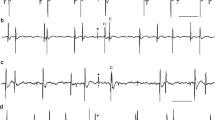Summary
Changes in the firing probability of voluntarily activated human tibialis anterior motor units occurred when the muscle nerve was stimulated below the threshold of motoneuron axons. A prominent period of increased firing probability was considered to result from the group 1 composite EPSP. The rise time of this composite EPSP, estimated from the duration of the period of increased firing probability, was between 2 and 5 ms. One estimate of the relative amplitude of the EPSP was derived from the cross-correlation and tested by inserting synthetic EPSPs into a computer simulation of a rhythmically discharging neuron. A second estimate of the amplitude was obtained by delivering stimuli with various delays within the interspike interval to determine the position (as a percentage of the mean interspike interval) at which the postsynaptic potential was capable of bringing the membrane potential to threshold. The two estimates were in reasonable agreement. The largest of these EPSPs could bring the motoneuron to threshold after 39% of the elapsed interspike interval. The falling phase of the postsynaptic potential was explored by delivering double stimuli within the interspike interval to produce temporal summation. The duration of the falling phase, so tested, was between 5 and 20 ms. An attempt was made to deduce the general form of the trajectory representing the effective distance of an EPSP from threshold during the interspike interval from the alterations in the cross-correlation profile that occurred when motoneuron firing rate was voluntarily altered.
Similar content being viewed by others
References
Ashby P, LaBelle K (1977) Effects of extensor and flexor group 1 afferent volleys on the excitability of individual soleus motoneurones in man. J Neurol Neurosurg Psychiatry 40: 910–919
Ashby P, Verrier M (1980) Human motoneuron responses to group 1 volleys blocked presynaptically by vibration. Brain Res 184: 511–516
Ashby P, Verrier M, Carleton S (1980) Vibratory inhibition of the monosynaptic reflex. In: Desmedt JE (ed) Spinal and supraspinal mechanisms of voluntary motor control and locomotion. Karger, Basel (Progress in Clinical Neurophysiology, vol 8, pp 254–262)
Ashby P, Zilm D (1978) Synaptic connections to individual tibialis anterior motoneurones in man. J Neurol Neurosurg Psychiatry 41: 684–689
Ashby P, Zilm D, Poppele RE (1978) The la EPSP in man. Soc Neurosci Abstr 4: 563
Ashby P, Zilm D (1982) Relationship between EPSP shape and cross-correlation profile explored by computer simulation for studies on human motoneurons. Exp Brain Res 47: 33–40
Buller NP, Garnett R, Stephens JA (1980) The reflex responses of single motor units in human hand muscles following muscle afferent stimulation, J Physiol (Lond) 303: 337–349
Burke RE (1968) Group la synaptic input to fast and slow twitch motor units of cat triceps surae. J Physiol (Lond) 196: 605–630
Calvin WH (1975) Generation of spike trains in CNS neurons. Brain Res 84: 1–22
Coombs JS, Eccles JC, Fatt P (1955) Excitatory synaptic action in motoneurones. J Physiol (Lond) 130: 374–395
Curtis DR, Eccles JC (1960) Synaptic action during and after repetitive stimulation. J Physiol (Lond) 150: 374–398
Delwaide PJ (1973) Human monosynaptic reflexes and presynaptic inhibition. An interpretation of spastic hyperreflexia. In: Desmedt JE (ed) New developments in electromyography and clinical neurophysiology, vol 3. Karger, Basel, pp 508–522
Fetz EE, Cheney PD (1980) Post-spike facilitation of forelimb muscle activity by primate corticomotoneuronal cells. J Neurophysiol 44: 751–772
Fetz EE, Gustafsson BG (1980) Relation between shapes of postsynaptic potentials and cross-correlogram peaks in cat motoneurons. Soc Neurosci Abstr 6: 715
Fetz EE, Jankowska E, Johannisson T, Lipski J (1979) Autogenetic inhibition of motoneurones by impulses in group la muscle spindle afferents. J Physiol (Lond) 293: 173–195
Garnett R, Stephens JA (1980) The reflex responses of single motor units in human first dorsal interosseous muscle following cutaneous afferent stimulation. J Physiol (Lond) 303: 351–364
Hendrie A, Lee RG (1978) Selective effects of vibration on human spinal and long loop reflexes. Brain Res 157: 369–375
Homma S, Nakajima Y (1979) Coding process in human stretch reflex analysed by phase-locked spikes. Neurosci Let 11: 19–22
Ito M, Oshima T (1962) Temporal summation of after-hyperpolarization following a motoneurone spike. Nature 195: 910–911
Kirkwood PA (1979) On the use and interpretation of cross-correlation measurements in the mammalian central nervous system. J Neurosci Methods 1: 107–132
Knox CK, Poppele RE (1977) Correlation analysis of stimulusevoked changes in excitability of spontaneously firing neurons. J Neurophysiol 40: 616–625
Kudina LP (1976) Effect of tendon reflex on motoneurons of human antagonistic muscle. Neirofiziologiia 8: 624–632
Kudina LP (1980) Reflex effects of muscle afferents on antagonist studied on single firing motor units in man. Electroencephalogr Clin Neurophysiol 50: 214–221
Noguchi T, Homma S, Nakajima Y (1979) Measurements of excitatory postsynaptic potentials in the stretch reflex of normal subjects and spastic patients. J Neurol Neurosurg Psychiatry 42: 1100–1105
Schwindt PC (1973) Membrane-potential trajectories underlying motoneuron rhythmic firing at high rates. J Neurophysiol 36: 434–449
Stephens JA, Usherwood TP, Garnett R (1976) Technique for studying synaptic connections of single motoneurones in man. Nature 263: 343–344
Trontelj JV (1973) A study of the H reflex by single fibre EMG. J Neurol Neurosurg Psychiatry 36: 951–959
Watt DGD, Stauffer EK, Taylor A, Reinking RM, Stuart DG (1976) Analysis of muscle receptor connections by spiketriggered averaging. 1. Spindle primary and tendon organ afferents. J Neurophysiol 39: 1375–1392
Author information
Authors and Affiliations
Rights and permissions
About this article
Cite this article
Ashby, P., Zilm, D. Characteristics of postsynaptic potentials produced in single human motoneurons by homonymous group 1 volleys. Exp Brain Res 47, 41–48 (1982). https://doi.org/10.1007/BF00235884
Received:
Issue Date:
DOI: https://doi.org/10.1007/BF00235884




